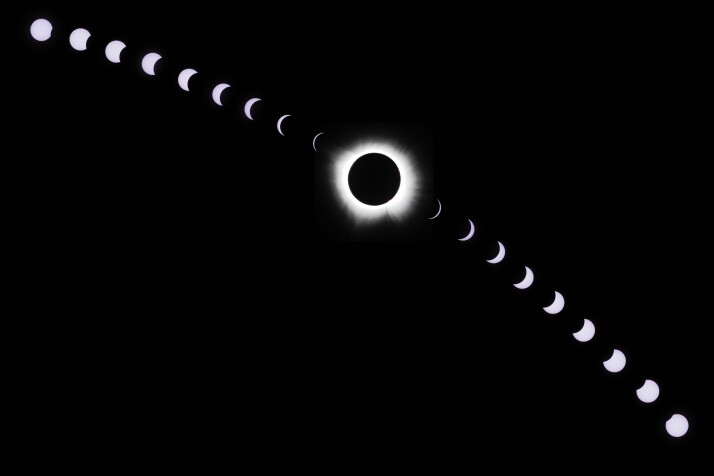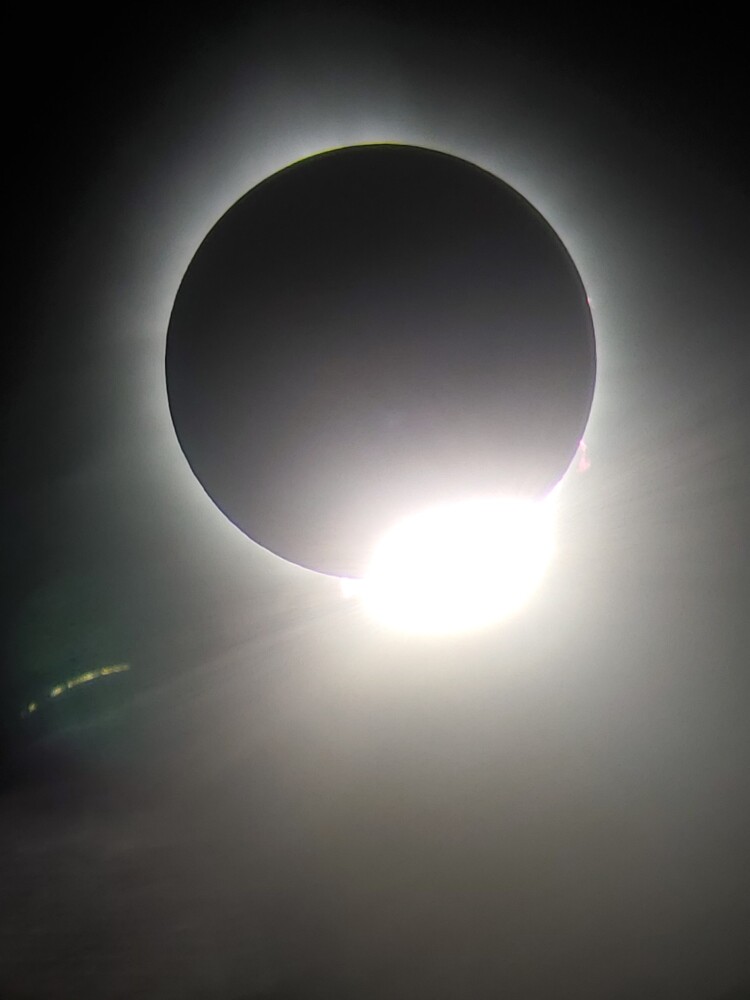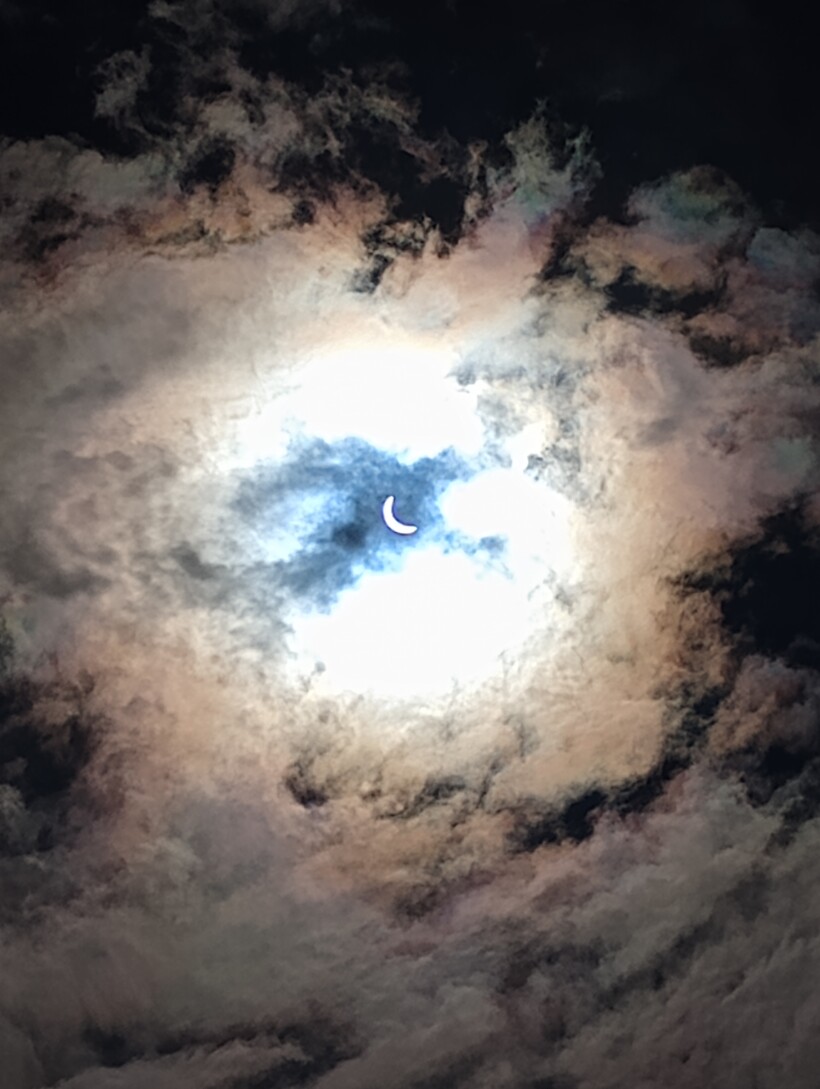Member Notes: The Solar Eclipse Experience - April 8, 2024

Photo sequence by Larry Tarr.
Richard Dyer, 1961 Inductee at Emory University
Our family traveled to Carbondale, Illinois, to experience totality. We brought a five-inch refractor with a solar filter and a projecting solar viewer based on a design from the College of Charleston (thank you, designer Terry Richardson!). We set these up behind our car, which we parked at the stadium at Southern Illinois University, and made sure the optics were working. Then we broke out the sunscreen, set up our umbrellas, and waited for first contact.
The notch in the solar disk appeared and slowly ate the sun. The few sunspots visible on the solar surface disappeared behind the moon one by one, the arc of the solar disk diminished to the vanishing point, and, right on schedule, the shining diamond ring introduced totality—an all-too-short four minutes of awesome totality, complete with the diamond ring effect, Bailey’s beads, and spectacular prominences along the southern edge of the sun. A huge prominence almost due south on the solar rim was visible to the unaided eye as a pink or reddish glow. Through the telescope, it appeared as a huge plasma arch that could easily hold the whole earth inside its loop! (Forgive my inadequate adjectives. Spectacular, awesome, phenomenal—none can quite express the wonderful sight.)
It was over much too soon, and the moon continued in its orbit, uncovering the sun in a second spectacular diamond ring that grew to an arc of solar disk enlarging by the second.

Big diamond. Photo by Richard Dyer.
Meleah Lanier, 2022 Inductee at Austin Peay State University
Our SPS chapter split up for the eclipse. Dedicated members led outreach efforts on our campus in Clarksville, Tennessee. They set up in the quad, offering solar eclipse glasses and hosting telescopes through which students could observe the partial eclipse. Meanwhile, our chapter’s executive council embarked on a journey to Columbus, Indiana—and totality—together. Only one of us had experienced totality before, so we had a mix of anticipation and excitement as we awaited the unique spectacle.
Keith Barnes, 1976 Inductee at North Dakota State University
My wife, Cheryl, and I experienced the eclipse at Bluff View Campground near Piedmont, Missouri. It was a “Whoa” experience when the sun disappeared behind the moon. Everyone around us reacted with an “Ooh” or “Ah,” and many dogs started barking. Our dog stood up on high alert for the entire period of darkness.

Solar prominences are visible during the total eclipse as seen from Piedmont, Missouri. Photo by Keith P. Barnes.
Michael Dowding, South Dakota School of Mines & Technology
It was a dark and stormy night, the weather shifting from rain to sleet to snow. The sky was filled with gray clouds from horizon to horizon. It seemed there was no hope of viewing the eclipse. Many had given up trying.
But NOT SPS!
We set up our tent and our telescope equipped with a solar filter in the middle of campus and began handing out the 200 eclipse glasses we had ordered from SPS. After all, what else were we going to do with them? Many scoffed at us for what was surely a futile effort—did we really expect the weather to cooperate?
But then... a miracle!
At the peak of the eclipse, a small hole opened in the clouds directly in line with our view of the sun! Success!
It lasted only a few minutes, but hundreds of people were able to view the eclipse. Then, just as suddenly, the clouds swallowed the sun, and it was all over.
We have a saying in South Dakota: “If you don’t like the weather, wait five minutes—It’ll change.”

Optimistic SPS members at South Dakota Mines prep for the eclipse. Photo courtesy of Michael Dowding.
Karen Williams, East Central University, 1986 Inductee at University of Arkansas

Despite last-minute advertising, at least 550 people turned out to view the eclipse at East Central University in Ada, Oklahoma, which reached 97.3% of totality. Photo by Karen Williams.
Dean Meyer, Augusta University
The SPS chapter at Augusta University hosted an eclipse viewing for the local community. Despite not being in the path of totality and only experiencing about 80% coverage, we had an amazing turnout of approximately 600 people! This exceeded our best expectations, particularly as the eclipse occurred during spring break for local schools and coincided with the Masters, a large international golf tournament in Augusta. We gave out all 500 pairs of eclipse glasses we had, with attendees gladly sharing with each other after we ran out, and we set up multiple telescopes for viewing. Our event even received positive coverage in local media. Reporters from three newspapers and two television stations interviewed chapter members and attendees and included the footage in their coverage.
Dalton Brindley, Central Michigan University
Our SPS chapter and the Central Michigan Astronomy Club (CMAC) took a joint trip down to the University of Toledo in Ohio to experience being in the path of totality. We got in touch with the SPS chapter there and joined them for a rooftop view of the eclipse, mingling with other SPS members as we waited for totality.

Totality from a rooftop in Toledo, Ohio. Photo courtesy of Jordan Nether and Dalton Brindley.
Miller Gruen, Loyola University

The view from the campus of Loyola University in Baltimore, Maryland. Photo by Miller Gruen.
Steven Ball, LeTourneau University
Since the path of totality would just miss us in Longview, Texas, we reserved a bus and five vehicles to transport equipment and people to a place to view the total eclipse. We went an hour north to Mt. Pleasant. As totality approached, we could see the sun disappearing by the minute. The excitement level was palpable as the noise from students, professors, and family grew to an unbridled level of squeals and shouts. It lasted nearly four minutes. The feeling was eerie and awesome at the same time. The corona glowed all around the edge of the moon. So glorious!
Tristan Rieman, Ohio University
I traveled out to Rossburg, Ohio, where my grandparents live, for the eclipse. I stayed up all night, hoping the rain would stop and making sure my astrophotography setup was ready to go in the morning. It cleared right as the sun came above the horizon. I tracked the sun through the day and through the eclipse. Totality was the most stunning and frantic three-and-a-half minutes, as I simultaneously tried to look at it, take pictures and video through my setup, and put the shield back on so I didn’t destroy my camera sensor. All went amazingly well, except for the hazy cloud that set in right as totality began.

Looking up from Rossburg, Ohio. Photo by Tristan Rieman.
Frank Efe, Inducted 2023 at Morgan State University

Students from Morgan State University’s electrical and computer engineering department view the eclipse in Baltimore, Maryland. Photo by Frank Efe.
James Lambe, Rose-Hulman Institute of Technology
I took this photo with a camera that had a makeshift solar filter made from a Monster energy drink box (crazy, I know). I was so blown away and completely mesmerized by totality that I stopped focusing on the camera and just pressed the shutter button while staring at the obscured sun with my jaw hanging open. Later I realized I had taken this picture—it’s the moment right before the sun reappeared, showing the diamond ring effect and solar flares.

Photo by James Lambe.
Akilah Goldson, Sarah Lawrence College
I drove to Burlington, Vermont, to visit my friends and to see totality with them. Thanks to my SPS chapter, I was able to bring eclipse glasses and viewing boxes made from cardboard, aluminum foil, and tape, which other spectators and I used to view the eclipse.

The eclipse over Lake Champlain. Photo by Akilah Goldson.
Laurel Larramendi, 2024 Inductee at Louisiana Tech University
Several Louisiana Tech University SPS students traveled to the path of totality in Clinton, Arkansas. We met people from the area and even learned a thing or two from others who had traveled across the nation to enjoy the phenomenon. We hosted a live broadcast of the event, sharing fun eclipse facts and safety precautions with viewers all over the world! We also shared a live feed of the entire eclipse as it was captured via telescope. Our members enjoyed meeting students from many different majors and backgrounds, and were able to bond over mutual interests and the incredible experience of viewing the total solar eclipse as a community.

SPS students from Louisiana Tech University keep tabs on the eclipse as it moves toward totality. Photo courtesy of Laurel Larramendi.
Larry Tarr, 1974 Inductee at Purdue University
We had really clear skies at the fairgrounds in Albion, Illinois. There were only a few jet contrails, and those were nowhere near the sun. I was about 200 feet from the centerline, along with probably 500 others from all over—mostly Chicago, Wisconsin, and Minnesota—and with equipment that included cell phones, DSLRs with telephotos, telescopes of all sizes, and a couple of telescopes outfitted with hydrogen-alpha filters to image the prominences and inner corona. It was an ideal site, with nearly unlimited horizons in all directions. We could easily see the approaching lunar shadow in the seconds before totality.
We had four minutes and six seconds of totality—unusually long, but NOT NEAR LONG ENOUGH! The corona on this eclipse was the best, largest, and most spectacular I have seen; the solar sunspot maximum is predicted to be later this year. I counted at least five really bright pink prominences on the edge of the sun during totality, which added to the awesome view. The temperature drop was especially noticeable this time (probably 8 to 10 degrees), and the eerie 360-degree twilight near the horizon with a dark sky overhead was really neat. Jupiter, Venus, Mars, and Saturn were easily visible in a straight line.
This was definitely one for the ages, and I was glad to be fortunate enough to cross it off my bucket list from under clear skies.

One for the ages. Photo sequence by Larry Tarr.





